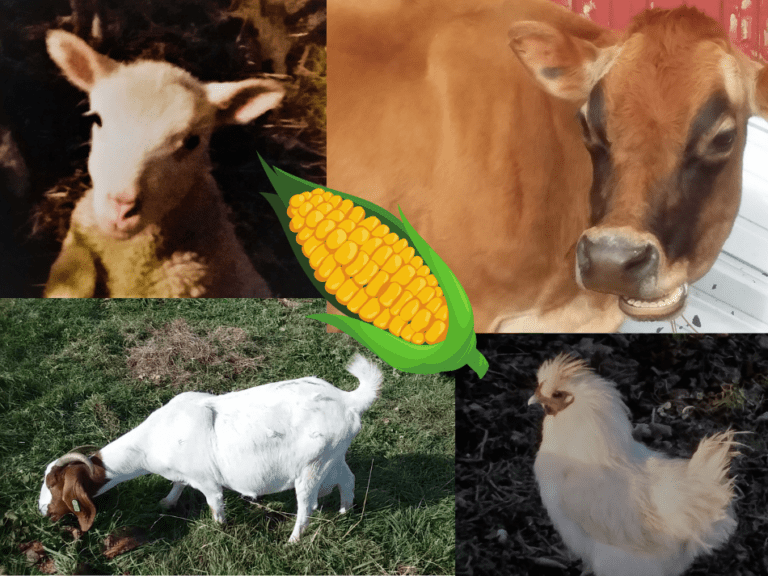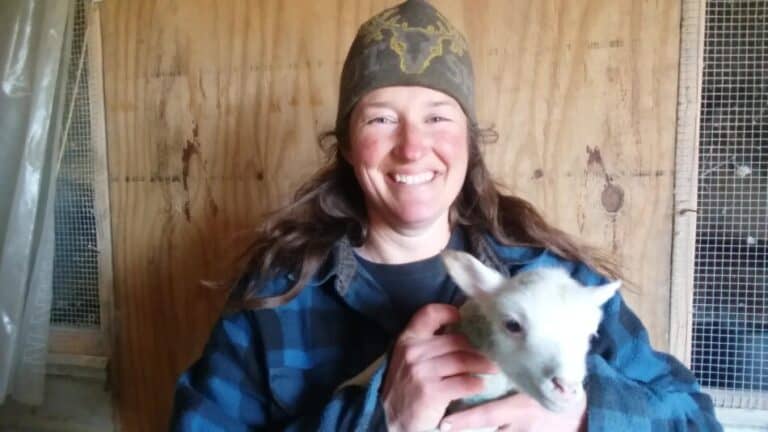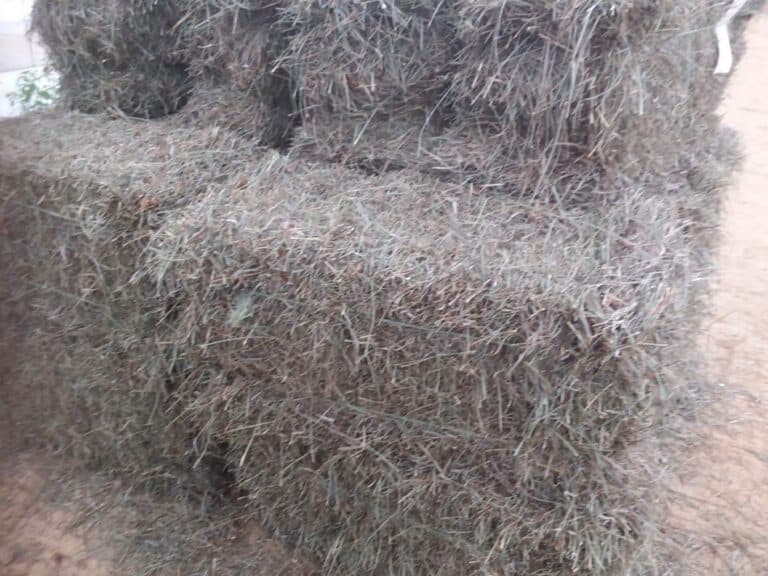The Cheapest Meat Animal To Raise (Chart And Cost Per Pound Of Meat Included)
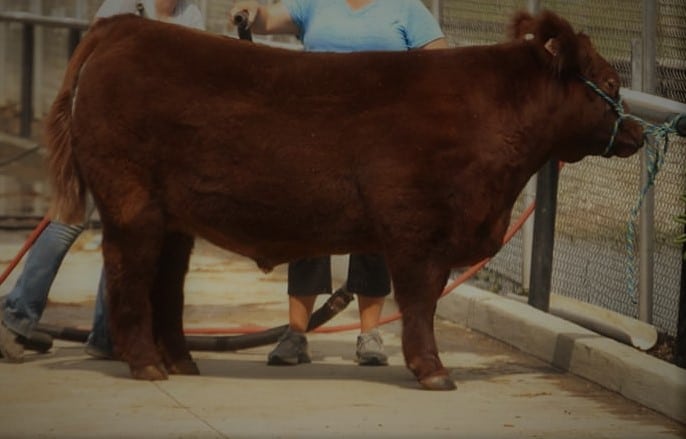
Wondering what the cheapest meat animal is to raise? I’ve got you covered. We will go over costs per animal and per pound of meat. Let’s get started!
The cheapest meat animal to raise is the broiler at $0.97 per pound. Grass feed beef is second at $1.64 per pound. Additionally, eggs can be raised for $0.33 per pound.
Farm Animals That Can Be Raised Together will show you combinations that work and ones that don’t!
| Meat Animal | Cost To Raise | $ Per Pound of Meat |
| Broiler-cheaper feed + you butcher | $4.40/bird | $0.97 |
| Broiler-more expensive feed + pay for butchering | $9.55/bird | $2.10 |
| Laying Hens-for eggs cheaper feed | $0.62/dozen | $0.33 |
| Laying Hens-for eggs expensive feed | $1.42/dozen | $0.76 |
| Feeder Pig-cheaper feed | $295.41 | $1.69 |
| Feeder Pig-expensive feed | $372.50 | $2.13 |
| Feeder Steer-grass only | $1223.20 | $1.64 |
| Duck- cheaper feed + you butcher | $8.92 | $2.23 |
| Duck- expensive feed + pay for butchering | $21.51 | $5.38 |
| Rabbit | $4.20 | $1.68 |
| Cheapest Meat Animal to Raise is the Broiler | $4.40/bird | $0.97/pound of meat |
Raising meat for your family is a wonderful way to become more self sufficient. I love knowing that when we raise an animal to eat we are giving the animal both a good life and a good death.
The second main attraction to raising your own meat is that you know exactly how the animal was raised, what it ate, what it didn’t eat, and if it had a happy life.
These are all factors that affect taste and nutrition of the meat.
Now, on to cost. Raising your own meat is normally a cost savings over buying meat raised in the same way from someone else.
Notice I did not say always. If you don’t keep an eye on your feed costs you can spend more than you had planned.
Nor did I compare the cost to the factory farmed, tasteless, “brine solution” soaked stuff you can easily buy in town.
The brine solution is a chemical mix to supposedly enhance flavor-the packages I have seen list the solution at 8%. That’s 8% of the package weight that you paid meat price for but got fake “salty” water.
Not to mention the fact that well raised wholesome meat does not need flavor enhancement.
For instance when we roast a broiler we just put it in the oven no preparations at all- just make sure it’s completely defrosted. Those birds taste great-tons of flavor!
Where to start your journey to self sufficiency? What is the least cost meat to raise? When can you can save money and when will buying high quality the first time save you money and hassle over time?
Main costs for raising your own meat
- Purchasing the animal
- Feed and Hay
- Equipment
Purchasing your animal(s), get high quality animals to start with
When purchasing animals to raise for meat for your family always buy a high quality healthy animal from a reliable source. The stock you start with will determine the outcome of your project.
Don’t cheap out at the beginning!
A “bargain” animal generally isn’t a bargain at all. Slow growth in less thrifty animals will quickly burn up your feed money and your time with little to show for it.
Buy high quality to get the fastest growing, healthiest animals. Healthy animals will actually be cheaper to raise, even if they cost a little more to get because they will save you on feed and vet costs.
Looking to get some feeder pigs? Buying Feeder Pigs will help you get started!
Maybe you are starting with poultry? How To Choose A Chicken Hatchery will show you how to decide where to place your order!
Feed and Hay are your largest reoccurring animal expenses
There are many places to buy feed and hay (if needed) for your animals. Generally speaking, buying in bulk saves you money per pound. Only buy enough feed for two to three weeks at a time.
Fresher feed is has more the nutrients because as soon as the feed grain is ground it starts to lose vitamins and the fats begin to go rancid.
This is a normal process all living things including food for you or your livestock loses nutritional value the longer it sets around.
Choosing High Quality Hay gives you a checklist of things to notice to tell if you are getting good hay!
The big money saver in feed is buying it from a feed mill in the 100 pound bags instead of the 50 pound bags at farm or pet stores.
From the price comparisons I have made buying from the feed mill is a little bit over half price of the 50 pound bags for twice as much feed!
For example, layer mash (the ground up feed for laying hens) is $15 for 50 pounds in the local farm store but it is $16.30 for 100 pounds at the feed mill. That’s a huge difference!
If you are able, another option is to grow the corn and purchase the other ingredients like soybean meal and the mineral supplement mix then grind the feed yourself.
This is what we do because it is a big money saver if you have the equipment.
Grinding our own feed cuts our costs down substantially.
For example: it costs us $6.60 per 100 pounds to make a broiler feed that would cost $16.30 to purchase at the feed mill and $30.00 to purchase at the farm store.

Before we had the grinder we would buy all the ingredients separately from the feed mill, weigh it out on small food scales we bought in town and mix it in 100 pound batches in the wheelbarrow.
When the broiler chicks were small this went okay, but when the chicks got big we were mixing up feed all the time and the batch was only 50 birds!
Some equipment (feeders, waterers, etc.) will be needed for your animals
On to equipment. Most livestock will require at least some equipment even if it is just a water trough or small feeders for chicks.
I am not going to include the cost of any equipment in these comparisons because you keep the equipment for next time.
Just be aware that some non feed purchases will need to be made if you don’t have something suitable already. It also depends upon the animal.
For instance, baby chicks need a reliable heat lamp, but it could be from another animal you raised or you could borrow it.
Or if you are grazing a feeder steer or two and have access to a fenced in pasture all they need is water and shade.
4 Must Have Items For Raising Feeder Pigs goes over your basic equipment needs.
Cost to raise each animal (by pound of meat in freezer)
- Broilers
- Laying Hens
- Feeder Pig
- Feeder Steer
- Ducks
- Rabbits
Of course, there are other animals you could raise (like lambs, goats, etc.), these are just a few ideas to get you started thinking!
Broilers are easy care and relatively cheap to raise
Broilers will eat 13.5 pounds of feed per bird. The cost of the feed per bag is $15.00 per 50 pounds ($30.00 per 100 pounds or 30 cents per pound). This is to a butchering weight of 6.5 pounds.
Hatchery price varies some with $2.00 each broiler as a good average price.
13.5 pounds of feed x $0.30/pound =$4.05 in feed cost/bird
Cost of each broiler chick=$2.00
Cost to butcher per bird=$3.50
This makes the total for a broiler $9.55 if you use the more expensive small bags of feed and pay to have it butchered.
The carcass weight of a broiler is 4.55 pounds (6.5 pounds live bird x 70% meat yield)=$2.10/pound of meat.
You can dramatically cut your costs if you use feed from a feed mill and butcher yourself.
This would save you the $3.50 per bird butchering fee plus about $2.20 (figuring the mill feed at $16.30/100 pounds) in feed.
Your cost per bird is $5.50 less than before making your new total cost per bird $2.00/chick +$2.20 in feed= $4.40 each if you butcher the broilers yourself. This bird costs you $0.97/pound of meat.
Consider reading my article Easiest Chicken To Raise For Meat for more information on broilers.

Laying Hens for eggs and as soup hens, later
Laying Hens will vary in cost depending upon if you raise the pullets (young hen) yourself or buy it. For more details read Is Raising Your Own Chickens For Eggs Worth It?
Raising the pullets to 16 weeks (just before she starts to lay eggs) will cost $3.00 per chick and require 11.36 pounds of feed costing $1.85 of feed mill feed or $3.64 of farm store feed.
If you raise the pullet and get your feed from the mill she will cost you $4.85. $3.00 chick price + $1.85 in feed= $4.85
If you decide to purchase the ready to lay pullet she will cost between $12-20 each. We will use $15.
Laying hens need 1.25 pounds of feed per week which equals $10.60 for the first year laying.
During the year she will lay about 25 dozen eggs at a cost of $0.62 per dozen. 52 weeks x 1.25 pounds of feed at $0.163/pound=$10.60
The more expensive feed will cost $20.80 each hen for the first year laying making the cost per dozen $0.83.
1.25 pounds/day x $0.32/pound =$0.40/week x 52 weeks=$20.80.
A ready to lay pullet feed the more expensive feed will cost $35.80 to lay for a year making the cost per dozen $1.42. A dozen eggs weighs 1.875 pounds making the cost $0.76/pound of eggs.
A pullet you raise yourself and feed the less expensive mill feed will cost you $15.45 to lay for one year making the cost per dozen eggs $0.62. These eggs cost $0.33/pound.
Update for 2022: since the cost of eggs is up significantly, layers may be more of a worthwhile enterprise than in previous years. You’ll get about 5 eggs per week per good layer then have a stewing hen later.
To read my article about calm chicken breeds that includes breed descriptions, click here.
Feeder Pigs grow quickly
Feeder pigs will need three pounds of feed for every pound of weight gain. You will be feeding your pig up to 250 pounds live weight.
Read Is Raising Your Own Pigs For Meat Worth It? for the details on a pig raising budget.
Since you are starting with a 60 pound feeder pig this is 190 pounds of weigh to grow to butchering size.
The total feed cost to raise each pig is $170.00 if you buy your feed in the 50 pound bags at the farm store. 570 pounds of feed x $0.30/pound=$170.00
You will also need to pay for butchering which will be $100.00 per head then $0.30/pound in packaging costs.
The carcass yield of a pig is 70% so you will have a 175 pounds of hanging weight.
Your total butchering costs will be $152.50 in this example. 175 pound carcass x $0.30/packaging + $100/head butchering charge=$152.50.
Your pig will have cost you $50 to purchase. (Remember to figure up these costs for your specific area. I have seen huge variations in both piglet and butchering costs.)
So your total cost per pound of meat if you pay for butchering and use the farm store feed is $372.50 which is $2.13/pound of meat.
The packaging costs will vary depending upon what specifically you want done, the more time consuming your request the more it will cost.
If you decide to get feed from the feed mill you will save money. The total cost is $295.41 which is $1.69/pound of meat.
A feeder pig is a great first project for raising your own meat, they grow fast, are adaptable and will yield quite a bit of meat per animal. Read my article When To Get A Feeder Pig for more details.
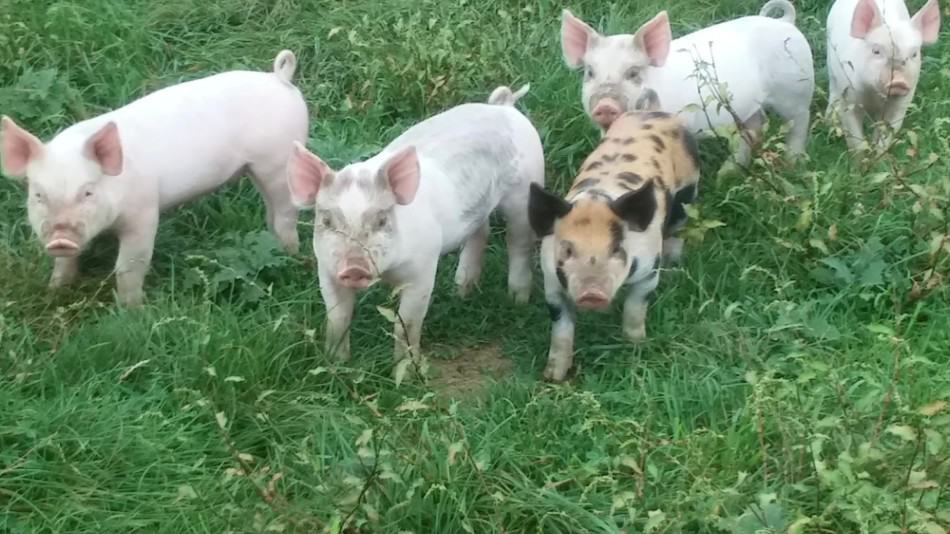
Feeder Steer will take longer, but can be done on grass
Feeder Steer is a bit more complicated to figure feed costs for. If you are feeding your steer on just grass then just figure the rent of the pasture.
Read Is Raising Your Own Beef Worth It? for a budget and ideas on raising your own beef.
The steer needs 1.8 acres of pasture (in an area that grows good grass), but be aware this number varies wildly depending upon where you live.
We’ll say $100.00 to rent the pasture.
The feeder steer is going to cost you $1.00-1.20/pound to purchase.
I am figuring you’ll want your steer to be just a summer project so he needs to be 750-800 pounds to start giving you 200 days for him to put on 2 pounds of weight per day.
A smaller steer will work fine and cost about the same per pound he will just take longer to finish since he started out weighing less.
We will go with $1.00 per pound and buying an 800 pounder so the cost of the steer is $800.00.
$800 for the steer +$100 pasture rent = $900 for a 1200 steer
The cost to butcher is $100 plus $0.30/pound packaging costs. The steer will dress out at 744 pounds (62% of live weight).
The total costs for your beef are $1223.20. That is $1.64 per pound of grass fed and finished beef.
The feeder steer is the animal with the most potential wiggle room in the price when it comes to purchasing an animal to raise for meat.
If you can get your steer for a better price and have plenty of grass to feed them, then grass feed beef becomes the cheapest meat to raise using the current prices.
My article Reading A Cattle Market Report will help you determine the current prices in your area.
Update: right now (early 2024) cattle prices are still fairly high for feeders, for a lower cost option, consider putting a cull cow in the freezer instead.
Ducks are fast growing meat birds

Ducks will be ready to butcher at 7-8 weeks of age if you are raising Pekins. Other ducks grow slower so they will take longer.
Your ducks will eat a total of 21 pounds of feed to get to butchering weight of 5-6 pounds.
Is Raising Ducks For Meat Worth It? will go over more of the considerations of raising meat ducks and will help you put together a budget.
If you purchase your feed at the farm store it will cost $15.50/ 50 pound bag so 21 pounds x $0.31/ pound feed=$6.51 in feed per duckling.
The cost of the duckling is $5.50 each. Plus the butchering cost which is $9.50 each.
$6.51 feed+ $5.50 duckling+ $9.50 butchering= $21.51 total=$5.38/pound
If you can get feed mill duck feed (we use broiler feed) it is $0.163/pound. $0.163/pound x 21 pounds =$3.42 per duckling feed costs
It is completely doable to butcher your ducks at home it just takes time because of all of the feathers, but it can be done. If you butcher at home and buy your feed at the mill your costs will be $8.92/duckling.
$3.42 feed + $5.50 duckling= $8.92 total =$2.23/pound of meat
More information on specific breeds of ducks to choose and those to steer clear of is in my article 16 Duck Breeds For Eggs And Meat.
Rabbits are wonderful backyard meat animals
Rabbits will eat 12 pounds of feed to get to 4 pound live weight.
Rabbit feed cost seems to be the same at the feed mill and at the farm store so there is no cost saving feed option here except try to use high quality hay.
Rabbit feed costs $17.50/ 50 pound bag so that is $0.35/ pound.
12 pounds of feed x $0.35/pound=$4.20 in feed per rabbit
Fryers (young rabbits raised for eating) will dress out at 2-2.5 pounds of meat. We’ll use 2.5.
$4.20 divided by 2.5 pounds =$1.68/pound of meat
Obviously, rabbits don’t just fall from the sky-you had to get them somewhere! I am not sure where to put the cost for the breeding stock, since price varies substantially by breed and location.
Most people getting started with meat rabbits would keep a trio-one buck and two does. They would cost you $20-30 each and have a litter of 8-10 babies every 2 months. That’s 48-60 bunnies per doe per year!
Another thing to keep in mind with rabbits is that after about 5 pounds live weight, feed conversion rates go from pretty good to terrible.
Getting a rabbit from around 5 pounds to more like 10 (adult size of commercial type meat rabbits) is super costly in feed, so these numbers will not hold if you decide to feed your rabbits to a larger size.
Read How Many Rabbits For A Family? to figure up how many breeders you should have depending upon how many times per week you want to eat rabbit.
I’ll show you how to calculate all this out, so you’ll have the meat you need.
Feed and animals costs will vary by location
Here is the catch to this whole article, feed costs and animal costs will vary by location and time of year.
Consider adjusting the time of year that you start your meat animal project, even pushing back the start date by a few months can make a huge difference.
For instance, in my area, a feeder pig purchased between mid March through mid June will be around $100-150 each.
These are feeder pigs running through the livestock auction, not special breeds or private sales, just piglets in spring.
If you buy that same feeder pig in July through February, you’ll pay around $60 each at the auction. The difference? The spring sales have the 4-H kids and their parents buying fair pigs, the fall sales do not.
In places where feeder pigs are hard to come by, $200-300 each is not unheard of. This is simply supply and demand. Check your local online ads, you’ll figure out which area you are in pretty quickly!
If you are looking at one of the more unusual breeds, you may easily see feeder pig prices that are higher still. For example, I just saw some Gloucester Old Spots in my local area with an asking price of $500 each.
Regarding feed, if you live in an area where the 50 pound sacks of brand name feed are all that is available, you’ll have to spend significantly more money on feed per animal.
Nothing wrong with that, as long as you have it in your budget.
Try looking into other sources of feed that would be available bulk, even if you have to drive a bit.
We have feed available in town (10 minutes away) but routinely drive 45 minutes for feed since there is a huge price difference.
Look around and see where people who are raising animals that are not show animals are buying their feed. A great place is look around the Amish community, they’ll have a feed source figured out.
Another option is to try working in some non feed foods for your pigs, like pasture or foraging in woodlot areas.
Pigs love vegetable scraps, my pigs love winter squash peelings but not beet skins. This is more workable for folks living close to produce growers, even farmer’s market growers have non sellable veg!
If you live near orchards or have neighbors that are big into recycling food waste, you’ve got another potential feed source for your animals.
Pigs and chickens, especially, are natural food waste eaters.
Look around your area and see what you can come up with. Unused resources, from orchard waste to right of way lands, can be used to help you raise your own meat.
When I can I give my pigs food scraps like vegetable peelings or edible weeds, like pigweed (which is an amaranth) to eat, rather than buying hay to go with their normal feed ration.
Food Waste For Pigs is a Penn State Extension article going over the things you should not feed your pigs. This same idea would apply to food wastes for chickens, as well.
Another thing to consider is that in some areas you can buy animals that other folks do not want to raise anymore-example: they got too many ducks and want to cut back on numbers.
If you know what it will cost you to raise ducks, you can see if the price these folks are selling their extra ducks for would make them a good purchase for you.
Related Questions
What is the best meat animal to start out raising?
The best meat animal to start out with is a broiler. They are fast growing and easy to care for.
What farm animals can live on grass?
All farm animals like to get outside and eat grass but only ruminants like cattle and sheep can grow well on grass alone.
Other animals, like pigs and chickens, can live without supplemental feed, if the have the right genetics, you are willing to accept what is likely to be lower production/slower growth and have the animals in an area of abundant other food sources.

